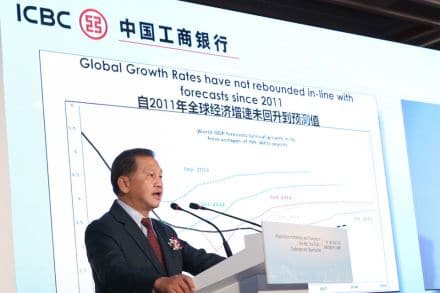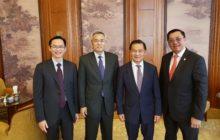Speech by Surbana Jurong & Changi Airport Group’s Chairman, Mr Liew Mun Leong at ICBC Seminar

Mr Yi Huiman, Chairman ICBC,
Mr Lim Hng Kiang, Minister for Trade and Industry,
Excellencies,
Dear Friends,
Ladies and Gentlemen,
Good morning,
It is my pleasure this morning to address you at ICBC’s forum on “Infrastructure Partnership and Financing in One Belt, One Road Challenges and Opportunities.”
We are all acutely aware that the global economy is again slowing down after the relatively few good years of recovery from the Global Financial Crisis in 2009. The IMF has in July downgraded world economic outlook for 2016 from 3.2% to 3.1%, the 5th time this year. The two charts you see on the screen does not foretell a pretty picture for both developed and emerging countries, except for slight improvements in China and Europe. These however, may not have fully factored in the negative impact of Brexit. Globally, investment is weak, with world trade slackening behind global income. Uncertainty abounds in the sudden awakening that Britain will leave Europe. We now live in a world of heightened fears of global terrorism and increased security problems. As many developed countries are experiencing income stagnation, inequality of incomes have created backlashes to capitalism in general and globalisation in specific. Human migration is now facing a pushback as countries start to review their immigration policies. Political malaise in the Middle East and the US election are certainly not helping to shore up confidence in the global economy.
Amidst all these doom and gloom, do we have some possible silver linings? In my view, there are two major possible stimuli or drivers that may have a chance to re-ignite global growth, namely the Trans-Pacific Partnership (TPP) and the One Belt One Road (OBOR) programme. The TPP programme is currently awaiting official ratification by the U.S. Government and much has been said on this already. Let us dwell today on the potential of the One Belt, One Road initiative instead.
Proposed in late 2013 and officially unveiled only in March 2015, One Belt One Road is an economic and diplomatic programme to transform world trade and to create regional collaboration. It is arguably the most ambitious economic project of the 21st century in terms of its size, scale and geographic spread. It is planned to connect 65 countries, embracing 65% of the world’s population, one third of the world’s GDP, 40% of the world’s trade and one quarter of all goods and services the world moves. It maps out an economic land belt on the original Silk Road connecting China to Central Asia, Middle East and Europe. There is also the Maritime Silk Road of shipping lanes linking China’s Ports to South East Asia, then to the African coast through the Suez canal to the Mediterranean, and finally ending up in Europe. It is difficult and too early to size up the cost of this mammoth infrastructure programme but McKinsey estimates that it could be as much as between $2 trillion to $3 trillion a year. It could power the world’s economy to grow extensively and exponentially, but is it feasible and if so what are the challenges and opportunities for China, as the sponsor, and for the rest of the 65 host countries?
Last Saturday, I sat on the panel of a plenary session at The Singapore Summit, together with Bill Winters, CEO of Standard Chartered Bank, Mark Tucker, CEO of AIA and Wang Yanzhi, President of the Silk Road Fund, to discuss the growth route of One Belt One Road programme. Haslinda Amin from Bloomberg moderated the discussion.
Let me share with you some of the questions and answers posed at the discussion as well as other commonly asked questions on OBOR that were posed to me and my answers to them as these issues are pertinent to our forum.
The first question often posed is: Why is China, who is now facing an economic slowdown at home, promoting such a huge overseas investment programme? My response is simply that the economic slowdown is precisely the reason why China is promoting this trade expansion programme. It is indeed China’s strategic trade expansion solution to her domestic economic slowdown problem.
Another question: Is this a feasible project for China, given its scale and size? Can China deliver these infrastructure programmes successfully?
I have been visiting and doing real estate and infrastructure business in China for the last 30 years, since the early 80s. Initially, I was always very sceptical about their very ambitious aspirations. But China has proven my scepticism wrong over and over again. For example, against all odds, they transformed Shanghai’s Pudong District, which in the 80’s and 90’s were just watery paddy fields, into a vibrant financial and commercial district with more high-rise buildings than any other city in the world. They successfully completed the massive Three Gorges Dam project and the Suzhou Industrial Park. Many cities have been upgraded. They have urbanised the country to 56% urbanisation rate now from 19.6% in 1980 and in the process lifted more than 700 million people out of abject poverty. These miraculous transformations were rapidly accomplished when China was still relatively poor and had limited financial resources. So far, every big public infrastructure project that the Chinese government has dreamt of has come to fruition.
During the 2009 crisis, China also had some success in stimulating the world’s economy by injecting some 4 trillion RMB (about $800 billion) to fuel her domestic economy with increased infrastructure projects. This in turn shored up the global commodity trade with emerging countries, especially in basic construction materials, and hence averted a free fall in their economies.
The OBOR projects which will involve overseas efforts by the Chinese and the necessary G-to-G co-operation will undoubtedly incur new challenges and require extra effort. But I am confident that the programme, with substantial endowment in financial resources, strong leadership and political will, will have a higher possible level of success.
What about financing and fund raising? How is that holding up?
The good news is that within just two years from the official announcement, China has started three funding initiatives to help seed the OBOR projects. These are the Asian Infrastructure Bank (AIIB) with $100 Billion in capital, the $40 Billion Silk Road Infrastructure Fund and the New Development Bank for BRICS with $100 Billion capital. This strongly signals China’s financial commitment to the programme.
One problem which plagues international infrastructure projects is their bankability. This is because they are not often well conceived or thoroughly planned, either because they lack detailed feasibility studies or were commissioned without clear objectives. Other failure factors are the lack of transparency in procurement processes and the lack of professional project management. Wastage, cost and time over runs and corruption often destroy their intended economic value. Such high risks put their bankability in suspect. Therefore the first step to secure financing for any infrastructure project is to ensure that the project is thoroughly planned, well designed and professionally managed by competent and trusted agencies. It is also crucial that government at both central and municipal level must be pro-business to support the implementation of these projects. Then the commercial lenders will have higher confidence in them, especially in the nascent stage of financing. When construction of the project is completed, the multi-lateral banks and agencies who have more patient funds can take over during the ensuing operational phase.
It is highly commendable that China has started three separate financial institutions and put them together in consortium with commercial lenders and other institutions to spearhead OBOR. I advocate that other financial agencies and institutions will take more interest to examine, rationalise and fully understand the risks involved in infrastructures projects and to open their minds to support them. My view is that if an infrastructure project is correctly conceived, well planned and designed and properly project managed, and sufficiently financed, it can be expected to generate stronger returns than many traditional investment projects.
Is China trying to exert her influence with the host countries covered by OBOR projects?
When development assistance is being offered to any emerging country, the intention is often being questioned and the ulterior motive is often over politicised. China’s infrastructure development programme has contributed to its economic progress and well-being of its people. Many emerging countries are still grossly deficit in infrastructures, and this has hindered their economic progress. It is very significant and indeed benevolent if China can export its development success and the spill-over benefits to its neighbouring countries. Naturally, there will be political goodwill generated as a result but that should not overshadow the mutual benefits between the collaborating countries involved. Singapore started off 50 years ago inviting the economic powers of US, Europe and Japan to collaborate and invest in our industry. It created jobs and employment for us. Look at where we are today. We are today what some may call a MNC economy. It brought us economic successes but we remain a politically neutral nation.
Another commonly posed question: Is China trying to export its excess capacities and capital overseas?
The answer is yes, especially its surplus in steel, cement, aluminium and other construction materials etc. That is what trading and investment business is all about, when you sell your surplus to the parties who need them. It is simply part of the supply demand business equation.
Besides infrastructure business, what other opportunities are there under the OBOR programme?
An Infrastructure programme creates a wide vista of opportunities for the development industry, including technical services providers such as planners, architects, engineers, project managers, contractors, and the associated professional services like accountants, lawyers, bankers and lenders, insurers etc. When the recipient countries are successfully urbanised, the whole host of modern city economies and business opportunities will be open up eg trade, education, shopping, tourism, life-style products and services etc.
So what can the Singapore Model offer to the OBOR programme? Singapore has for the last 50 years invested heavily in urbanisation and infrastructure development. It has a solid track record of successful infrastructure development which we can attribute our economic success to. We have developed many world class projects like airport, seaport, roads, highways , public housings, power station, water, subway and digital infrastructures etc and can certainly share our technical expertise with other countries. We also have the critical mass of global financial institutions with infrastructure financing options, supported by a robust legal and regulatory framework for good governance.
In conclusion, OBOR is a very powerful strategy conceived to facilitate trade between China and potentially up to 65 other countries. Carried to its full potential, it will certainly increase and facilitate trade amongst the OBOR countries. In my view, it is certainly a pragmatic strategy to re-ignite the current slowdown in the global economy which will benefit not only China but also the 65 OBOR countries. This mammoth programme will encounter many challenges and scepticism, but at the same time it will present many opportunities. There are real projects in the pipeline and there are of course risks involved. Having business opportunities to address and manage, whatever the risk there may be, is better than having absolutely no business opportunity and with no risks. I often advocate that no global CEO should miss China in their business strategy. OBOR is yet another matter that they should constantly keep on their radar.
Thank you.
About Surbana Jurong
Surbana Jurong (SJ) has a rich 50-year heritage in the development of Singapore’s urban, industrial and infrastructure landscape. SJ traces its roots to the Housing Development Board (HDB) and the Jurong Town Corporation (JTC), agencies synonymous with Singapore’s early township and industrialisation efforts.
Headquartered in Singapore, Surbana Jurong Private Limited (SJ) was formed in June 2015 through the merger of renowned urban planning & affordable housing design expert Surbana International Consultants, and Jurong International, Singapore’s premiere industrial and infrastructure engineering design stalwart.
In August 2016, SJ acquired world-renowned infrastructure engineering designer SMEC Holdings. With this acquisition, SJ now boasts a combined global workforce of 10,000 employees in over 95 offices across 40 countries in Asia, Australia, the Middle East, Africa and the Americas. SJ is also presently the largest Asia-based urban, industrial and infrastructure consulting firm. SJ today provides one-stop consultancy solutions across the entire value chain of urbanisation, industrialisation and infrastructure domains.
SJ’s motto ‘Building Cities, Shaping Lives’ reflects its belief that development is more than just steel and concrete. SJ creates spaces and infrastructure services where people live, work and play, shaping cities into homes with sustainable jobs where communities and businesses can flourish.



 Download Article
Download Article 


